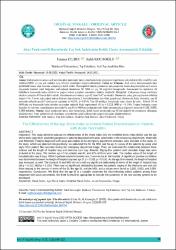Akut pankreatitli hastalarda yaş şok indeksinin kritik hasta ayrımındaki etkinliği

Göster/
Erişim
info:eu-repo/semantics/openAccesshttp://creativecommons.org/licenses/by-nc/3.0/us/Tarih
2022Üst veri
Tüm öğe kaydını gösterÖzet
Amaç: Çalışmamızın amacı acil serviste akut pankreatit tanısı alan hastalarda prognozu öngörmede şok indeksi (SI), modifiye şok
indeksi (MSI) ve yaş şok indeksi (yaş SI)’nin etkinliğini değerlendirmektir. Gereç ve Yöntem: Acil servis başvurusunda akut
pankreatit tanısı alan hastalar çalışmaya dahil edildi. Retrospektif olarak planlanan çalışmamızda hasta dosyalarından acil servis
triyajında bakılan vital bulguları kullanılarak hastaların SI, MSI ve yaş SI değerleri hesaplandı. Sonrasında bu indeksler ile
hastaların hastanede kalış süreleri ve yoğun bakım yatışları arasındaki ilişkiyi inceledik. Bulgular: Çalışmaya triyaj verilerine
eksiksiz ulaşılan 85 hasta dahil edildi. Hastalarımızın ortanca yaşı 62 iken %47’si erkekti. Hastanede yatış gün sayılarının ortanca
değeri 4’tü. 5 hasta için yoğun bakım ihtiyacı duyulurken, 2 hastada hastane içi ölüm gerçekleşti. Hastanede kalış süresiyle, yaş SI
arasında anlamlı pozitif korelasyon saptandı (r=0.265, p=0.014). Yaş SI arttıkça, hastanede kalış süresi de arttı. Klasik SI ve
MSI’nde ise hastanede kalış süreleri açısından anlamlı ilişki saptanmadı (SI-p = 0.213, MSI-p = 0.150). Yoğun bakımda yatan
hastalar ile serviste yatan hastalar arasında SI, yaş SI ve MSI açısından anlamlı ilişki saptanmadı, p değerleri sırasıyla 0.150, 0.093,
0.059 bulundu. Sonuç: Akut pankreatit tanısı alan hastalarda, kritik hasta ayrımında yaş SI’nin değerli bir parametre olduğunu
düşünüyoruz. Yeni geliştirilecek skorlama sistemlerine dahil edilmesinin uygun olacağını düşünmekteyiz. Objective: This study aimed to evaluate the effectiveness of the shock index (SI), the modified shock index (MSI), and the age
shock index (age SI) in predicting prognosis in patients diagnosed with acute pancreatitis in the emergency department. Materials
and Methods: Patients diagnosed with acute pancreatitis at the emergency department admission were included in this study. In
the study, which was planned retrospectively, we calculated the SI, the MSI, and the age SI values of the patients by using vital
signs from patient files recorded during the emergency department triage. Then, we examined the relationship between these
indexes and the length of hospital stay and intensive care stay. Results: Eighty-five patients with complete triage data were
included in the study. The median age of the patients was 62, and 47% of them were male. The median value of the length of
hospitalization was 4 days. While 5 patients needed intensive care, 2 were exitus in the hospital. A significant positive correlation
was determined between the length of hospital stay and age SI (r = 0.265, p = 0.014). As the age SI increased, the length of hospital
stay increased, as well. The classical SI and MSI did not yield any significant relationship in terms of the length of hospital stay
(SI-p = 0.213, MSI-p = 0.150). There was no significant relationship between the patients staying in the intensive care unit and
those staying in the service in terms of the SI, the age SI, and the MSI, and p values were found as 0.150, 0.093, and 0.059,
respectively. Conclusion: We think that the age SI is a valuable parameter for discriminating critical patients among those
diagnosed with acute pancreatitis. We think it would be appropriate to include this parameter in the new scoring systems to be
developed.
Kaynak
Balıkesir Sağlık Bilimleri DergisiCilt
11Sayı
1Koleksiyonlar
Aşağıdaki lisans dosyası bu öğe ile ilişkilidir:


















